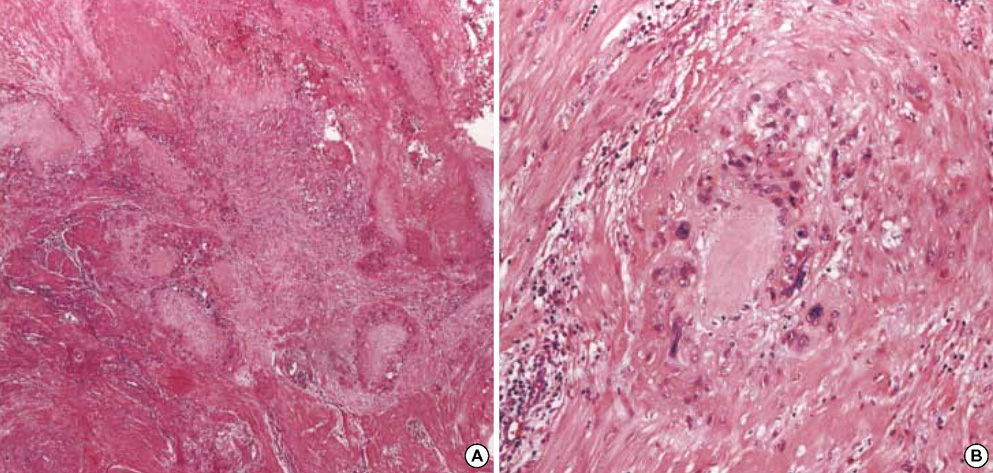J Korean Med Sci.
2007 Oct;22(5):932-935. 10.3346/jkms.2007.22.5.932.
A Case of Placenta Increta Presenting as Delayed Postabortal Intraperitoneal Bleeding in the First Trimester
- Affiliations
-
- 1Department of Obstetrics and Gynecology, Women's Cancer Clinic, Yonsei University College of Medicine, Seoul, Korea. shkim70@yumc.yonsei.ac.kr
- 2Women's Cancer Clinic, Yonsei University College of Medicine, Seoul, Korea.
- 3Department of Pathology, Yonsei University College of Medicine, Seoul, Korea.
- KMID: 1713308
- DOI: http://doi.org/10.3346/jkms.2007.22.5.932
Abstract
- Placenta increta is an uncommon and life-threatening complication of pregnancy characterized by complete or partial absence of the decidua basalis. Placenta increta usually presents with vaginal bleeding during difficult placental removal in the third-trimester. Although placenta increta may complicate first and early secondtrimester pregnancy loss, the diagnosis can be very difficult during early pregnancy and thus the lesion is difficult to identify. We encountered with a woman who was diagnosed with placenta increta after receiving emergency hysterectomy due to intraperitoneal bleeding 2 months after an uncomplicated dilatation and curettage in the first trimester. Therefore, we report this case with a brief review of the literature.
MeSH Terms
Figure
Reference
-
1. Breen JL, Neubecker R, Gregori CA, Franklin JE. Placenta accreta, increta, and percreta. A survey of 40 cases. Obstet Gynecol. 1977. 49:43–47.2. Berchuck A, Sokol RJ. Previous cesarean section, placenta increta, and uterine rupture in second-trimester abortion. Am J Obstet Gynecol. 1983. 145:766–767.
Article3. Clark SL, Koonings PP, Phelan JP. Placenta previa/accreta and prior cesarean section. Obstet Gynecol. 1985. 66:89–92.4. Liu X, Fan G, Jin Z, Yang N, Jiang Y, Gai M, Guo L, Wang Y, Lang J. Lower uterine segment pregnancy with placenta increta complicating first trimester induced abortion: diagnosis and conservative management. Chin Med J. 2003. 116:695–698.5. Ecker JL, Sorem KA, Soodak L, Roberts DJ, Safon LE, Osathanondh R. Placenta increta complicating a first-trimester abortion. A case report. J Reprod Med. 1992. 37:893–895.6. Harden MA, Walters MD, Valente PT. Postabortal hemorrhage due to placenta increta: a case report. Obstet Gynecol. 1990. 75:523–526.7. Jacques SM, Qureshi F, Trent VS, Ramirez NC. Placenta accreta: mild cases diagnosed by placental examination. Int J Gynecol Pathol. 1996. 15:28–33.
Article8. Miller DA, Chollet JA, Goodwin TM. Clinical risk factors for placenta previa-placenta accreta. Am J Obstet Gynecol. 1997. 177:210–214.
Article9. Fox H. Placenta accreta, 1945-1969. Obstet Gynecol Surv. 1972. 27:475.
Article10. Gielchinsky Y, Rojansky N, Fasouliotis SJ, Ezra Y. Placenta accreta-summary of 10 years: a survey of 310 cases. Placenta. 2002. 23:210–214.
Article11. Suh YH, Song EH, Kim DH, Lee YH, Park HY, Koh KS, Park CH. A clinical study of placental adhesions: placenta accreta, placenta increta, and placenta percreta. Korean J Obstet Gynecol. 2003. 46:81–88.12. Finberg HJ, Williams JW. Placenta accreta: prospective sonographic diagnosis in patients with placenta previa and prior cesarean section. J Ultrasound Med. 1992. 11:333–343.
Article13. Lam G, Kuller J, McMahon M. Use of magnetic resonance imaging and ultrasound in the antenatal diagnosis of placenta accreta. J Soc Gynecol Investig. 2002. 9:37–40.
Article14. Chou MM, Ho ES, Lee YH. Prenatal diagnosis of placenta previa accreta by transabdominal color Doppler ultrasound. Ultrasound Obstet Gynecol. 2000. 15:28–35.
Article15. Haynes DI, Smith JH, Fothergill DJ. A case of placenta increta presenting in the first trimester. J Obstet Gynaecol. 2000. 20:434–435.16. Yang JJ, Xiang Y, Wan XR, Yang XY. Diagnosis and management of uterine arteriovenous fistulas with massive vaginal bleeding. Int J Gynaecol Obstet. 2005. 89:114–119.
Article17. Choi GD, Choi WK, Lee HS, Kim CB, Lee GN. A case of spontaneous rupture of the uterus with placenta increta in early pregnancy. Korean J Obstet Gynecol. 1996. 39:1359–1364.18. Lee YT, Lee MH, Moon H, Hwang YY. A case of placenta increta which was found about 50 days after induced abortion at 1st trimester. Korean J Obstet Gynecol. 2000. 43:1298–1301.19. Kim MJ, Kwen I, Kim JA, Hur SY, Kim SJ, Kim EJ. A case of placenta increta presenting as delayed postabortal hemorrhage. Korean J Obstet Gynecol. 2005. 48:755–759.20. Roh HJ, Park SK, Hwang JY, Cho HJ, Lee SH, Lee HA, Choi JW, Kim SH, Chae HD, Kim CH, Kim GR, Kang BM. Placenta increta complicating a first trimester abortion: a case report. Korean J Obstet Gynecol. 2004. 47:1828–1832.
- Full Text Links
- Actions
-
Cited
- CITED
-
- Close
- Share
- Similar articles
-
- Placenta Increta Presenting as Postabortal Uterine Mass in the First Trimester: A Case Report
- A Case of Placenta Increta Presenting as Delayed Postabortal Hemorrhage
- Placenta increta presenting as postabortal uterine mass and hemoperitoneum in the first trimester: A case report
- A Case of placenta increta which was found about 50days after induced abortion at 1st Trimester
- A Case of Placenta Increta Complicating a First Trimester Abortion



